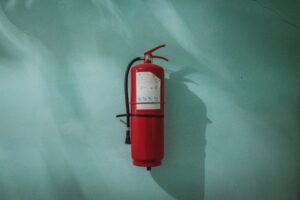Why Water Isn’t Always the Solution ?
Water is dangerous when poured over oil fires like those caused by cooking grease fires or gasoline. Oil and water do not mix, and, as a result, water causes the flammable liquid to splatter, thus spreading the fire. This is also true for engine fires the way water does not mix well with burning materials and hot metals. But what type of fire can be put out safely with water? This knowledge isn’t just academic—At such incidents when grease, electrical, or any other non-water compatible fires are not involved, it may prove to be life saving.
Water is a conductor of electricity. Using this on electrical fires increases the risk of shocks or electrocution, which could lead to serious injury. It is important for homeowners to understand that not all fires are the same.
Fires You Should Never Put Out with Water
- Class B Fires (Flammable Liquids): Fires that are classified under this category include fuel, gas, or alcohol fires. Water will run and spread the liquids, making the problem worse.
- Class C Fires (Electrical Fires): When the origin of a fire is from faulty wiring or electrical equipment, water becomes extremely dangerous when dousing it, as electricity conducts water and increases the chances of electrocution.
- Class D Fires (Metal Fires): Fires that involves metals such as magnesium or aluminum cannot be extinguished with regular fire extinguishers since using water intensifies the fire.
- Class K Fires (Cooking Oils & Fats): Water in the kitchen fire will increase it as it will cause the oil to boil and splatter.
Class A Fires (Ordinary Combustibles):
It includes fires from combustion of materials like paper, wood and textile. Here water is very effective since it cools down the burning material and so reduces the heat. The easiest and safest solution for trash or paper fire in backyards is water.
What’s Your Next Move?
Invest in Fire Safety Tools
House fires come in many forms, and being prepared to tackle each type is essential. Here’s what you need to know to effectively combat different kinds of fires.
- Class A Extinguishers (Paper, Wood): $30–$75
- Class B & C Extinguishers (Oil, Gasoline, Electricity): $50–$150
- Class K Extinguishers (Kitchen Grease Fires): $100–$200

Strategically placing fire extinguishers near fire-prone places such as kitchens and garages to keep them safe is necessary. It is equally important to know what type of fire can be put out safely with water.
Where To Buy Them?
You can purchase fire extinguishers at various places, including:
- Local Hardware Stores. Well-known chains sell various extinguishers for different applications, e.g., Home Depot, Lowe’s, Ace Hardware.
- Online Retailers: Leading platforms like Amazon and Walmart offer various options, often with customer reviews to help guide your choice.
- Specialized Safety Equipment Suppliers: Grainger or smaller fire safety shops sell good extinguishers, whether for home use or commercial purposes.
- Big Box Stores: Costco, Target, etc. will commonly carry basic models suitable for home protection.
Again, while shopping, ensure certification and safety standards applicable to your locality; remember to check extinguishers regularly to ensure the working condition.
Understanding what type of fire can be put out safely with water and when to use alternative methods could prevent a small mishap from becoming a catastrophe.
With the recent history of wildfires in the City of Angels, the urge to learn about fire safety and practice fire prevention skills becomes even stronger. Strong winds and dry conditions risk fires in other areas, and hence residents are cautioned to use the utmost care. On the other hand, large-scale wildfires usually call for professional intervention. It is always useful to know how to put out small preventable home fires. Fires involving materials like paper, wood, or fabric can often be put out early by using enough water at the right time.
The small fires, on the other hand, serve as powerful reminders of how important it is for each individual to prepare and know the types of fires that have taken place in their area in order to protect homes and families at the personal level. Homeowners can take proactive steps to put themselves in a position to mitigate fire threats through the recognition of the use of water and making certain precautions are in place.
Previous